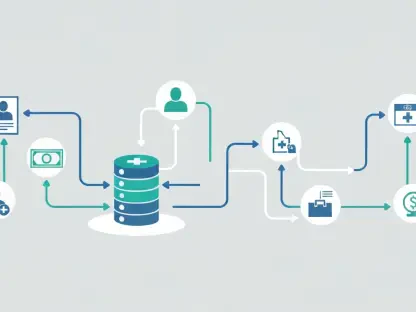In an era where data is the lifeblood of business innovation, Cisco is carving out a transformative path by integrating Splunk, a leader in data analytics, into its expansive technology ecosystem. More than a year after the acquisition, Cisco has unveiled groundbreaking strategies at the .conf25 event that aim to revolutionize how organizations interact with data across diverse environments—from the edge to the cloud. This strategic partnership goes beyond mere tool consolidation; it’s about breaking down long-standing barriers to data access and empowering businesses with seamless, AI-enhanced insights. By embedding Splunk’s robust capabilities into its framework, Cisco is addressing the complexities of modern data landscapes, where information is often scattered across hybrid and multi-cloud setups. This article explores the pivotal innovations driving this vision, shedding light on how Cisco is reshaping data management to meet the demands of a digital-first world with unparalleled efficiency and intelligence.
Breaking New Ground with Cisco Data Fabric
The launch of the Cisco Data Fabric represents a bold step forward in tackling the challenges of distributed data environments. This innovative framework enables organizations to connect and access data wherever it resides—be it at the edge, on-premises, or in the cloud—without the cumbersome need to centralize it into a single repository. Described as creating interconnected “data puddles” rather than a monolithic data lake, this approach offers remarkable flexibility and efficiency. Powered by Splunk’s deep data processing expertise, the Cisco Data Fabric aligns seamlessly with the realities of today’s hybrid infrastructures, ensuring that businesses can harness their data assets without the constraints of traditional architectures. This decentralized yet cohesive system is poised to redefine how enterprises manage vast and varied data sources, making accessibility a cornerstone of operational success in a fragmented digital landscape.
Beyond its connectivity prowess, the Cisco Data Fabric integrates advanced AI capabilities that elevate its impact on data-driven decision-making. A standout feature is the Time-Series Foundation Model (TSFM), tailored specifically for time-series data such as IoT sensor outputs or machine-generated logs. Unlike conventional statistical tools, TSFM excels in predictive analytics and forecasting, even adapting to scenarios it hasn’t encountered during training. This adaptability is crucial for industries reliant on real-time insights, offering a significant edge over outdated methods. By embedding such AI innovations, Cisco addresses intricate data challenges with precision, enabling organizations to anticipate trends and respond proactively. The fusion of Splunk’s analytical strengths with AI-driven tools within the Data Fabric underscores Cisco’s commitment to not just managing data, but transforming it into a strategic asset for forward-thinking enterprises.
Seamless Integration via Splunk Federated Search for Snowflake
One of the most practical advancements unveiled at .conf25 is the Splunk Federated Search for Snowflake, a feature designed to eliminate the friction of working across disparate data platforms. This integration allows users to query data stored in Snowflake alongside information within Splunk’s environment without the need to relocate or duplicate datasets. By maintaining data in its original location and adapting queries to Splunk’s familiar interface, this solution streamlines workflows and minimizes disruptions. Such functionality is a game-changer for teams juggling multiple systems, as it reduces the technical hurdles that often hinder efficient data analysis. Cisco’s focus on simplifying cross-platform interactions demonstrates a keen understanding of the real-world challenges faced by organizations navigating complex data ecosystems, paving the way for more cohesive and productive operations.
This integration also reflects Cisco’s broader dedication to interoperability, a pressing need in an era of fragmented data architectures. The Splunk Federated Search for Snowflake ensures that users can derive insights without toggling between disconnected tools, fostering a unified experience that enhances usability. This isn’t merely about technical compatibility; it’s about empowering businesses to focus on outcomes rather than processes. By prioritizing intuitive access to data across environments, Cisco addresses a critical pain point for many enterprises, enabling them to combine diverse datasets effortlessly for richer analytics. This strategic move aligns with the vision of creating an open, interconnected architecture where data silos become a relic of the past, and actionable intelligence is just a query away, reinforcing Cisco’s role as a facilitator of streamlined data management in a multi-cloud world.
Splunk’s Evolution into Cisco’s Strategic Core
What began as a security-centric acquisition has transformed into a cornerstone of Cisco’s overarching data and AI ambitions, with Splunk now playing a central role in driving innovation. Initially focused on immediate synergies in security and observability, Splunk’s integration has expanded to power critical initiatives like the Cisco Data Fabric, AgenticOps, and AI Canvas. Key components, such as the Splunk Machine Data Lake—a virtual catalog tailored for machine data—support advanced AI training and analytics, highlighting the depth of this partnership. This evolution signifies a shift from tactical integrations to a comprehensive strategy where Splunk underpins Cisco’s ability to manage and extract value from data across varied landscapes. Such a transformation showcases how Splunk has become indispensable to Cisco’s mission of turning raw information into strategic insights for modern enterprises.
Further illustrating this strategic alignment, Splunk’s capabilities are now integral to addressing the complexities of data observability and advanced analytics within Cisco’s portfolio. Far from being a peripheral tool, Splunk acts as the engine propelling Cisco toward a future where data location is irrelevant to its utility. This deepened integration enables organizations to leverage AI-driven solutions for operational efficiency, predictive maintenance, and beyond, all while maintaining the integrity of distributed data sources. The progression from a security-focused asset to a foundational element of Cisco’s data strategy marks a significant milestone, reflecting a vision where seamless access and intelligent processing converge. As Splunk continues to shape Cisco’s approach to data challenges, it solidifies its position as a vital component in crafting solutions that anticipate the needs of a rapidly evolving digital economy.
Reflecting on a Data-Driven Legacy
Looking back, the strides made by Cisco through its integration with Splunk, as showcased at .conf25, marked a defining moment in the journey toward reimagined data access. The introduction of the Cisco Data Fabric and the Splunk Federated Search for Snowflake stood as testaments to a commitment to decentralized, user-friendly data management enhanced by AI innovation. These initiatives not only tackled existing barriers but also set a precedent for how technology giants could leverage partnerships to address industry-wide challenges. Moving forward, organizations inspired by this model should consider adopting flexible data architectures and prioritize interoperability to stay competitive. Exploring AI tools tailored to specific data types, such as time-series models, could further unlock predictive capabilities. As the digital landscape continues to shift, the focus should remain on building systems that make data an accessible, actionable resource, ensuring businesses are equipped to navigate future complexities with agility and insight.









